
TNU Journal of Science and Technology
229(07): 40 - 48
http://jst.tnu.edu.vn 40 Email: jst@tnu.edu.vn
INCOHERENT DICTIONARY LEARNING WITH LOCALITY CONSTRAINED
LOW-RANK REPRESENTATION FOR IMAGE CLASSIFICATION
Nguyen Hoang Vu*, Tran Quoc Cuong
Tien Giang University
ARTICLE INFO
ABSTRACT
Received:
20/02/2024
Low-rank representation (LRR) plays a significant role in image
classification tasks due to its ability to capture the underlying structure
and variations in image data. However, traditional low-rank
representation-based dictionary learning methods struggle to leverage
discriminative information effectively. To tackle this issue, we propose
an incoherent dictionary learning approach with locality-constrained
low-rank representation (LCLRR-IDL) for image classification. Firstly,
we introduce low-rank representation to handle potential data
contamination in both training and test sets. Secondly, we integrate a
locality constraint to recognize the intrinsic structure of the training
data, ensuring similar samples have similar representations. Thirdly, we
develop a compact incoherent dictionary with local constraints in the
low-rank representation to classify images, even in the presence of
corruption. Experimental results on public databases validate the
effectiveness of our approach.
Revised:
28/3/2024
Published:
29/3/2024
KEYWORDS
Image Classification
Low Rank Representation
Locality Constraint
Dictionary Learning
Incoherent Dictionary
HỌC TỪ ĐIỂN KHÔNG MẠCH LẠC VỚI RÀNG BUỘC CỤC BỘ ĐẠI DIỆN
HẠNG THẤP TRONG PHÂN LOẠI HÌNH ẢNH
Nguyễn Hoàng Vũ*, Trần Quốc Cường
Trường Đại học Tiền Giang
THÔNG TIN BÀI BÁO
TÓM TẮT
Ngày nhận bài:
20/02/2024
Biểu diễn hạng thấp (LRR) đóng một vai trò quan trọng trong các
nhiệm vụ phân loại hình ảnh do khả năng nắm bắt cấu trúc cơ bản và
các biến thể trong dữ liệu hình ảnh. Tuy nhiên, các phương pháp học từ
điển dựa trên biểu diễn hạng thấp thường gặp khó khăn trong việc tận
dụng thông tin phân biệt trong hình ảnh một cách hiệu quả. Để giải
quyết vấn đề này, chúng tôi đề xuất một phương pháp học từ điển
không mạch lạc với ràng buộc cục bộ trong đại diện hạng thấp
(LCLRR-IDL) để phân loại hình ảnh. Đầu tiên, chúng tôi giới thiệu
cách biểu diễn hạng thấp để xử lý nhiễu trong dữ liệu huấn luyện và
kiểm tra. Thứ hai, chúng tôi kết hợp ràng buộc cục bộ để nhận biết cấu
trúc đa dạng nội tại của dữ liệu huấn luyện, đảm bảo các mẫu tương tự
có cách biểu diễn tương tự nhau. Thứ ba, chúng tôi huấn luyện một từ
điển không mạch lạc nhỏ gọn với các ràng buộc cục bộ trong biểu diễn
hạng thấp để phân loại hình ảnh. Kết quả thử nghiệm trên cơ sở dữ liệu
tiêu chuẩn đã xác nhận tính hiệu quả của phương pháp đề xuất.
Ngày hoàn thiện:
28/3/2024
Ngày đăng:
29/3/2024
TỪ KHÓA
Phân loại hình ảnh
Đại diện hạng thấp
Ràng buộc cục bộ
Học từ điển
Từ điển không mạch lạc
DOI: https://doi.org/10.34238/tnu-jst.9733
* Corresponding author. Email: nguyenhoangvu@tgu.edu.vn

TNU Journal of Science and Technology
229(07): 40 - 48
http://jst.tnu.edu.vn 41 Email: jst@tnu.edu.vn
1. Introduction
In recent years, dictionary learning (DL) has garnered increasing attention within the image
classification and signal processing communities. Dictionary learning algorithms have emerged
as prominent methods in the field of image processing, showcasing the superiority of learned
dictionaries over pre-designed ones like wavelets in image reconstruction tasks. This is because
dictionaries learned directly from training images can capture more complex and diverse image
structures, leading to more accurate and faithful reconstructions compared to fixed, pre-designed
dictionaries. The effective application of DL in image restoration tasks has consequently spurred
its adoption in image classification problems. Recent research has seen a rise in the development
of discriminative dictionary learning (DDL) methods that make use of label information to
achieve enhanced classification performance. Unlike standard dictionary learning, these DDL
methods aim to learn a dictionary by optimizing an objective function that integrates both
reconstructive and discriminative terms. There are several great DDL methods such as LC-KSVD
[1], FDDL [2], ODFDL [3], SMLFDL [4]. These methods simultaneously learn the dictionary
and classifier by incorporating different classification losses on the coding vectors. While
conventional dictionary learning (DL) methods excel in various classification and recognition
tasks, their performance diminishes significantly when the training data is heavily contaminated
by factors such as occlusion, lighting/viewpoint variations, or corruption. To overcome these
limitations, several dictionary learning (DL) methods have emerged, integrating rank
minimization into the sparse representation framework. These approaches have shown promising
outcomes, particularly in scenarios with significant noise presence [5], [6]. In addition, the
importance of local information in data has been widely recognized in various practical
applications, especially in sparse coding and dictionary learning. Many studies have built a
dictionary learning algorithm with local constraints to fully exploit local information in training
data [7] - [9].
Previous studies have demonstrated the pivotal role of dictionary quality in bolstering the
efficacy of sparse representation methods. Researchers have dedicated significant efforts towards
learning high-quality dictionaries. Dictionary learning techniques typically prioritize enhancing
both the reconstruction accuracy and discriminative power of the dictionary. This paper
introduces a novel algorithm called Locality Constrained Low Rank Representation - based
Incoherent Dictionary Learning (LCLRR-IDL) for image classification. The propose algorithm
incorporates a locality constraint term to effectively capture the intrinsic manifold structure of the
training data. By enforcing this constraint, similar samples are encouraged to have similar
representations. Compared to other dictionary learning methods, we explicitly incorporate an
incoherent penalty in the dictionary learning model to make the dictionary more discerning.
Contaminated images can be recovered during our dictionary learning process. The main
contributions of this paper are summarized as follows:
(1) We adopt low-rank and sparse representation to handle potential data contamination in
both training and test images.
(2) By integrating the locality constrained term, this approach promotes the similarity between
samples in terms of their representations. This ensures that similar samples are given comparable
representations. The resulting learned representations can be used directly for classification
purposes, without the need for further processing or feature extraction.
(3) We learn a compact incoherent dictionary with local constraints in the low-rank
representation to classify images even in the presence of corruption.
The rest of this paper is outlined as follows: Section 2 introduces the proposed methodology.
Section 3 illustrates the Experimental Results and discussions. Finally, Section 4 concludes this paper.

TNU Journal of Science and Technology
229(07): 40 - 48
http://jst.tnu.edu.vn 42 Email: jst@tnu.edu.vn
2. Methodology
2.1. Low-Rank and Sparse Representation
Liu et al. [10] presented a low-rank representation (LRR) method to recover the subspace
structures from data that reside on a union of multiple subspaces. LRR is based on the
assumption that all data are sufficiently sampled from multiple low dimensional subspaces
embedded in a high-dimensional space. Assume that data samples are drawn from a union of
many subspaces, the LRR model aims to seek the low-rank representation and the sparse noises
based on the given dictionary . Specifically, LRR is formulated as the following rank
minimization problem:
‖ ‖ (1)
Leveraging both low-rank and sparse representation, the method known as Learning Low-
Rank and Sparse Representation (LRSR) [11] is formulated as follows:
‖ ‖ ‖ ‖ (2)
Given the non-convex nature of the problem above, a common approach is to replace the -
norm with the - norm and the rank function with the nuclear norm. Consequently, the
optimization problem (2) is relaxed into the following formulation:
‖ ‖ ‖ ‖ ‖ ‖ (3)
The nuclear norm ‖ ‖ defined as the sum of all singular values of Z, while ‖ ‖ represents
the - norm, which is the sum of the absolute values of entries in the given matrix. Parameters
and control the sparsity of sparse noise E and sparse representation Z, respectively, and D is the
dictionary that linearly spans the data space.
2.2. LCLRR-IDL Method
2.2.1. Definition of LCLRR-IDL
Given a training dataset , where c is the number of classes, d
denotes the feature dimension, and is the samples from class i which has ni samples.
From X, we learn a discriminative dictionary D and the coding coefficient Z, which is utilized to
future classification task. The objective function is designed to facilitate learning an incoherent
dictionary and low-rank representation while imposing locality constraints. This is achieved by
explicitly integrating a correlation penalty into the dictionary learning model:
‖ ‖ ‖ ‖ ‖ ‖ ‖ ‖ ‖ ‖
(4)
The term ‖ ‖ represents a locality-constrained term aimed at uncovering local
geometric information [12]. It serves to enhance the sparsity of the objective function, which
proves advantageous for classification tasks, particularly when employing a sparse graph that
delineates locality relationships. denotes the Hadamard product and ‖ ‖
; ‖
‖
is the incoherent term. Minimizing the incoherent term guarantees that the dictionary can
efficiently represent the input samples and achieve higher accuracies for classification tasks. The
-norm of E is used to model sample-specific corruptions and outliers. There are four
regularization parameters that reflect relative contributions
of each term.
2.2.2. The Optimization of LCLRR-IDL
In this section, we adopt the high efficiency Augmented Lagrange Multiplier (ALM) method
[13] to solve the proposed LCLRR-IDL. Firstly, we introduce three auxiliary variables J, L and Q
to make the problem (4) become easily solvable. Thus, we convert problem (4) into the following
equivalent optimization problem:

TNU Journal of Science and Technology
229(07): 40 - 48
http://jst.tnu.edu.vn 43 Email: jst@tnu.edu.vn
‖ ‖ ‖ ‖ ‖ ‖ ‖ ‖ ‖ ‖
(5)
The corresponding augmented Lagrangian function for equation (5) can be written as:
‖ ‖ ‖ ‖ ‖ ‖ ‖ ‖ ‖
‖
〈 〉 〈 〉 〈 〉 〈 〉
‖ ‖
‖ ‖
‖ ‖
‖ ‖
(6)
where are Lagrange multipliers, is the penalty parameter, and 〈 〉 is trace of
. We iteratively solve problem (6) by updating J, Z, L, Q, E and D once at a time. The
detailed procedures are as follows:
(1) Updating J: Fix the other variables and solve the following problem:
‖ ‖ 〈 〉
‖ ‖
‖ ‖
‖ (
)‖
(7)
where (
), and | | is the soft – thresholding
(shrinkage) operator.
(2) Updating Z: Fix the other variables and solve the following problem:
〈 〉 〈 〉 〈 〉 〈 〉
(‖ ‖
‖ ‖
‖ ‖
‖ ‖
)
*( ) + *( ) ( ) ( )
+ (8)
(3) Updating L: Fix the other variables and solve the following problem:
‖ ‖ 〈 〉
(‖ ‖
)
‖ ‖
‖ (
)‖
[
] (9)
(4) Updating Q: Fix the other variables and solve the following problem,
‖ ‖ 〈 〉
(‖ ‖
)
‖ ‖
‖ (
)‖
(10)
The elementwise strategy allows for the updating of each element individually. For the (i, j)
element , the optimal solution of problem (10) is:
| |
‖ ‖
(
(( ) )) (11)
(5) Updating E: Fix the other variables and solve the following problem:

TNU Journal of Science and Technology
229(07): 40 - 48
http://jst.tnu.edu.vn 44 Email: jst@tnu.edu.vn
‖ ‖ 〈 〉
(‖ ‖
)
‖ ‖
‖ (
)‖
[
] (12)
(6) Updating D: Fix the other variables and solve the following problem:
‖ ‖
〈 〉
‖ ‖
(13)
The optimization problem (13) can be solved via the first-order gradient descent method [14]:
{ ( )} (14)
where ‖ ‖
〈 〉
(‖ ‖
),
( ) represents the gradient of ( ) with respect to , parameter denotes the step size,
and represents the projection function that maps each column to the -norm unit ball. The
optimization process of (4) is summarized in Algorithm 1.
Algorithm 1: Optimization procedure of LCLRR-IDL
Input: Training sample , parameter and .
Initialize: , , , , , , , ,
, , and is initialized by randomly selecting training samples.
While not converged do
1. Compute the optimal solution of J, Z, L, Q, E and D according to (7), (8), (9), (10), (12)
and (13) respectively.
2. Update the Lagrange multipliers by
( ); ( );
( ); ( ).
3. Update the parameter by ( )
4. Check the convergence conditions
‖ ‖ , ‖ ‖ , ‖ ‖ , and
‖ ‖ .
End while
Output: Z, D, and E.
2.2.3. Classification
To classify the test data, we utilize a linear classifier in the testing phase, following the
approach outlined in Ref. [11]. The coefficients for training samples and
for testing samples
are obtained through Algorithm 1. Subsequently, we can learn a linear classifier W based on the
coefficients of training samples and their corresponding labels:
‖ ‖
‖ ‖
(15)
where H represents the label matrix of training samples, is the weight of the regularization
term. The label for test sample i is determined by:
(16)
where is corresponding to the classifier with the largest output.





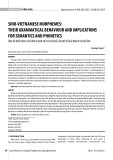


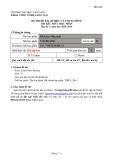
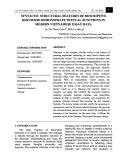
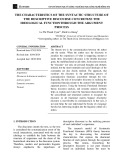
![Bộ câu hỏi trắc nghiệm Văn bản tiếng Việt [chuẩn nhất]](https://cdn.tailieu.vn/images/document/thumbnail/2025/20251127/thuynhung051106@gmail.com/135x160/24021764296609.jpg)


![Bài giảng Ngôn ngữ học đối chiếu Nguyễn Ngọc Chinh [PDF]](https://cdn.tailieu.vn/images/document/thumbnail/2025/20251101/vovu03/135x160/7471762139652.jpg)





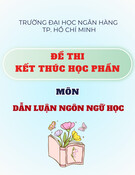

![Ngân hàng câu hỏi môn Tiếng Việt thực hành [chuẩn nhất]](https://cdn.tailieu.vn/images/document/thumbnail/2025/20251003/kimphuong1001/135x160/21861759464951.jpg)
![Bài giảng Văn học phương Tây và Mỹ Latinh [Tập hợp]](https://cdn.tailieu.vn/images/document/thumbnail/2025/20251003/kimphuong1001/135x160/31341759476045.jpg)


